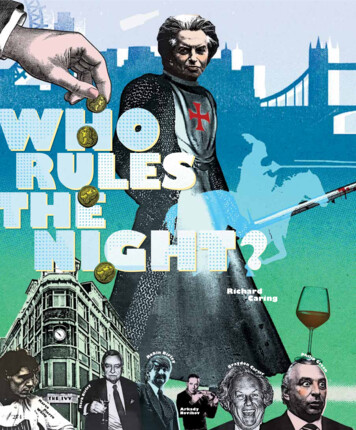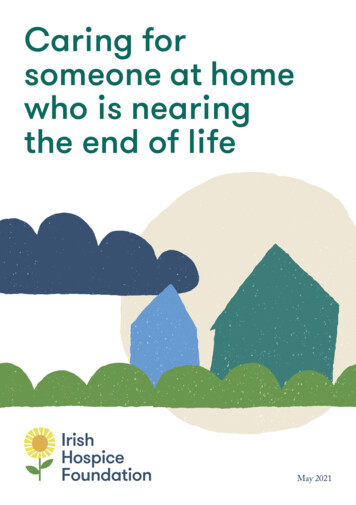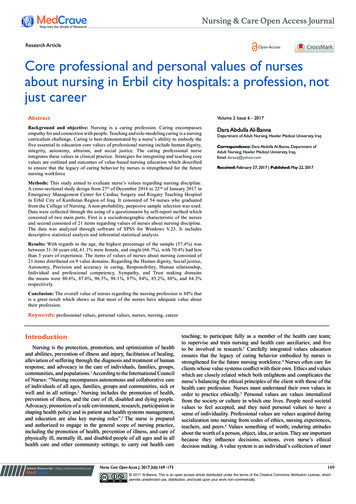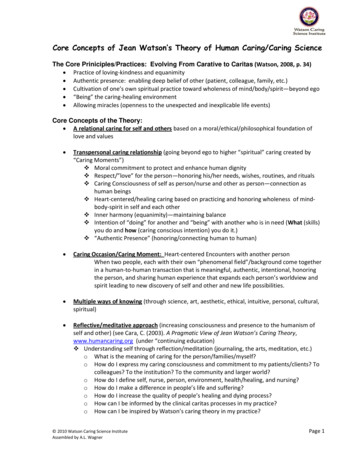
Transcription
RichardCaringobin BirPhileRyeyrlBi274MarkWarhcoPiit ere reArkadyNovikovrterGrnMCalipeeGdonr ay
JeremyKingCKe i t hsincribhaaineel CMiChorMc Na l lyTwo names dominate London’scafé society: Showy RichardCaring operates his acquisitions(the Ivy, Le Caprice) likea business tycoon, whereasdemure Jeremy King overseeshis properties (the Wolseley,Colony Grill Room) with arestaurateur’s eye. Michael Grossinvestigates the fierce battleto seat the city’s Who’s Who.Illustration by Jimmy TurrellPeterLanganGordonRamsay
Generating the most heat of all are two leading men, Richard Caring and Jeremy King, who sit atop two competing dining empires,Caprice Holdings and Corbin & King, respectively.Caring, 67, who is compact and tightly wound, with remarkablebouffant hair, bright white teeth, and an unlined face, and the tall,suave, twinkly eyed and bearded King, 61, may be visual opposites,but they have much in common, notably sovereignty over restaurantsfavored by the see-and-be-seen set. But Caring, King (along with hislongtime business partner, Chris Corbin), and their individualcrowds are as different as traditional London is from the international cosmopolis it has become. Caring caters to the brash new London, the wealthy arrivistes from elsewhere who’ve made it Europe’sworldliest city, while King seems dedicated to reminding patrons ofwhat’s made London so magnetic for eons.Think of London and you also think of civility, even when, justbeneath the surface, feelings are anything but civil. A deeper lookreveals this as a war between London’s superstar mealmongers. “Inthe red corner, the dyed-in-the-wool, old-fashioned restaurateurKing, versus, in the blue corner, the relative newcomer, heavyweightbusinessman Richard Caring,” announces Ben Elliot, who is something of a ringmaster as the cofounder of the international conciergeservice Quintessentially. “The stakes are high in the 21st-century culinary capital of the world,” Elliot continues.The winner will no less than rule the night.Caring’s and King’s restaurants have distinct identities.All offer world-class dinner theater, beginning with atangible sense of arrival—what Englishman-in-NewYork Keith McNally, Caring’s partner in a Londonbranch of the Balthazar brasserie, has described as “ablast of energy” on walking in the door, the buzzy feeling that you’reabout to get much more than a meal. Good food is only part of it.Mere mortals book tables long in advance or at awkward hours,they pull strings or rank (pulling out cash doesn’t work) or take achance and just show up, hoping to get lucky and score a table, particularly at the top-tier rooms like Caring’s Le Caprice, Scott’s, andthe Ivy, or Corbin & King’s most electric room, the Wolseley. Then,there’s the question of where you’re seated: in the center of the con-276centric rings of the Wolseley? The front room of Le Caprice? Findyourself there and you’ve been cast as a leading player, blessed by thepsychic spotlight that shines on those tables and sight lines that letyou see the rest: Isn’t that Woody Allen and Soon-Yi Previn tuckedinto the corner banquette at Le Caprice? Jeffrey Archer at the Delaunay? Kate Moss at the Wolseley? Photographer Terry O’Neill, wearingbattered sneakers and all black, entertaining a pair of Yanks at Scott’s?But there are no Playbills here, and the hovering, attentive staff havebeen sworn to silence about the cast. “It’s like a club,” says Jose Torres,who has worked at Le Caprice for 17 years. “We know where they liketo sit, what they like to drink.” And what not to say about them.Between them, Caprice Holdings and Corbin & King run 18 ofLondon’s most desirable restaurants, as well as private clubs, a catering service, and a brand-new hotel, the Beaumont. They include themodern Le Caprice off Piccadilly, lined with classic David Baileyphotos; the dark and cozy West End landmarks the Ivy and J.Sheekey; grandly theatrical rooms like the Wolseley and BrasserieZédel; the opulent seafood palace Scott’s; masculine chophouses likethe Ralph Lauren–esque Colony Grill Room and sleek 34; neighborhood hangouts like the French-style café Colbert on Sloane Squareand a Viennese equivalent, Fischer’s, on Marylebone High Street; anda classic ladies-who-lunch spot on the King’s Road, the Ivy ChelseaGarden. Though all rise to the occasion, Michelin-starred meals aregenerally not the point; fish and chips with mushy peas are on manyif not most of the menus. These dining rooms are all about the vibe.Chris [Corbin] and I have always believed in things subliminal,” says Jeremy King, who has opened their sixcurrent restaurants. When creating new places, King(the active partner) invents stories for each, then designs them like sets for their imagined scenarios. So theDelaunay—in King’s fiction, the slowly expanded creation of twobrothers escaping pogroms in middle Europe, and named, like theWolseley, for an old auto brand—is a grand European-style caférestaurant, with old-wood-and-brass decor and a menu boastingWürstchen and schnitzel, Sacher torte, and Bavarian blue cheese. TheBeaumont hotel and its hypermasculine Art Deco–ish Colony GrillRoom are inspired by Sherman Billingsley’s Stork Club and are thePREVIOUS SPREAD: DAVID CANNON/GETTY IMAGES (CARING); NEALE HAYNES/CONTOUR BY GETTY IMAGES (NOVIKOV); RICHARD YOUNG/REX/REX USA (LANGAN); RICHARD LEVINE/DEMOTIX/CORBIS (MCNALLY); RICHARS YOUNG/REX USA (M. BIRLEY); GREG GAYNE/ 20TH CENTURY FOX FILM CORP./EVERETT COLLECTION (RAMSAY); HEATHCLIFF O’MALLEY (GREEN); TRINITYMIRROR/MIRRORPIX/ALAMY (CAINE); THE ESTATE OF BOB CARLOS CLARKE/THE LITTLE BLACK GALLERY (WHITE); GLENN COPUS (R. BIRLEY); DAVID M. BENETT/GETTY IMAGES (CORBIN)Think of London and inevitablyyou think of the stage. Yet theplay’s not the only thing anymore.Now in a city where cuisine waslong ago an afterthought—if it wasthought about at all—restaurantsare the hottest tickets in town.
ostensible creation of a fictional character, Jimmy Beaumont, an expatriate hotelier from Prohibition-era New York. Brasserie Zédel, morea complex than a restaurant—complete with a sidewalk café, a thimble-sized cabaret, and a grand underground dining salon—is a take onthe real-life Bouillen Chartier, in Paris, where the room is as big as theprices are gentle, “both a special treat for a student and a canteen for theaffluent,” says King, “where a taxi driver can sit down with a duchess.”Corbin & King’s Fischer’s is similarly modeled on a Viennese Konditorei, or pastry shop. But it’s the requisite backstory of their latestplace, Colbert, that really takes the cake. Located on Sloane Square, itsimagined owner, Pierre, seduced the daughter of his boss in a Pariscafé, and then fled to London where, impecunious, he built one of hisown, room by room, leaving the paneling endearingly inconsistent.The attention to detail is as tasty as the classic crustaceans, confit, andcassoulet Colbert serves. But imaginative as he is, King could havenever conceived of the story of how he and his competitor Caring became the clashing kings of London cuisine.like David Bailey. “The most interesting people are often the leastaffluent,” says King. “We’re interested in people for who they are, notwhat they earn. We’re not impressed by money.” They hold to thatphilosophy today; a magazine writer eating a 10 grilled-cheesesandwich might dine next to a mogul scarfing down a 60 Dover soleat the Colony Grill Room.But money does matter, and it wasn’t long before MargaretThatcher’s 1986 deregulation of the London Stock Exchange stokedthe appetites that produced British superchefs such as Marco PierreWhite and Gordon Ramsay and popular spots like the River Caféand Terence Conran’s Bibendum. By the time Tony Blair’s Cool Britannia of the ’90s was overthrown by today’s new order of international finance, London’s restaurant scene was cooking on 12 burners.In 1998, Corbin and King were onto their third restaurant revival,J. Sheekey. They’d bought the 102-year-old landmark off LeicesterSquare out of liquidation that year, but renovations had stretched themto their financial limits and Corbin wasfeeling vulnerable; he’d been diagnosedn 1917 Abel Giandellini boughtwith leukemia a week after they reopenedan unlicensed café in London’sthe Ivy and had had a bone-marrow transCorbin andWest End and hired Mario Gallatiplant in 1994. Just then, the owner ofKing “areas its maître d’. The Ivy’s namechains of pizza and mussels-and-beer resdamn good atcame later, from one of the thestaurants offered to buy them out for “whatwhat they do,”pians who loved its inexpensive food andseemed like a lot of money, about 23 milsays Richardwho told Giandellini his clients wouldlion,” and leave them in charge. They tookCaring. “We’recling to him like ivy. In 1947, Gallati40 percent of the purchase price in shares.opened Le Caprice, near the Ritz on PicThat was their undoing. “They made misnot frightened.cadilly, and it elbowed the Ivy into irreltakes,” King says. “And then our share priceThis is aevance, attracting the likes of Noël Cowfell,” and after two years, they walked awaybusiness.ard, Laurence Olivier, and Vivien Leigh.from Le Caprice, the Ivy, and J. Sheekey.Maybe that’sBy the 1970s, Le Caprice had faded, too.They decided to open a hotel and, whilethe differenceAt the same time, Chris Corbin was manlooking for a property (losing several opporbetween aaging hotspot Langan’s Brasserie, cotunities along the way: “We tried to be genowned by Irish restaurateur Peter Langantlemen,” says King, “then somebody withrestaurateurand the actor Michael Caine. Jeremyelbows and a checkbook would push us outand an owner.”King held Corbin’s same title at the Lonof the way”), found the space that becamedon outpost of the Broadway -actorthe Wolseley. King, who’d taken the leadhangout Joe Allen’s. The two West Coundue to Corbin’s illness, had always dreamttry boys became friends when Peter Langan tried to hire King.of opening a grand café. Their new venture, named after the cars soldIn 1980, Moroccan-born Joseph Ettedgui, namesake of the Joseph in the 1920s in the landmarked former auto showroom, was an imfashion brand, approached Corbin to open a restaurant, and he in- mediate success, in 2003, but, “We screwed up,” King continues. Aftersisted King be involved. They settled on the moribund Caprice, and 16 years of going it alone, they’d brought in investors: three propertyEttedgui leased it but soon fought with his partners over its new decor. owning billionaire brothers who sold their interest to a financial groupAfter it reopened and immediately started losing money, Ettedgui is- that was promptly brought down by the Great Recession. “They didn’tsued an ultimatum: They had three weeks to buy him out. King’s par- have any money,” says King. “We were left in limbo.” By then a rivalents used their home as collateral for a loan to help them take it over, had entered London’s restaurant scene.and it soon became a favorite of art dealers, actors, and magazine folk.King had first visited the Ivy in the mid-’70s. “It was old, deichard Caring’s office building is a stone’s throw fromcrepit, and I was fascinated,” he says. Beginning in 1983, he andthe site where his father, Luigi Caringi, ran a LondonCorbin repeatedly offered to buy it, but their offers were spurned.garment showroom, selling “dresses for elderly laWhen it went on the market in 1989 they pounced.dies,” Caring says. Luigi was an American casualty ofWorld War II, a Neapolitan Catholic who’d marriedKing says he and Corbin took an American approach to runningrestaurants. “We wanted to break rules. We weren’t obsequious.” his nurse, a London-born Jewish girl of Polish descent.Caring (his father dropped the last vowel from their name) quitThey also took a cue from the egalitarian Chelsea trattorias of the1960s, where aristocrats dined alongside up-from-the-streets types school at 15, in 1965, to join the family business. Eighteen monthsIR277
later, he struck out on his own, selling miniskirts and hot pants. His the second charge, “In an industry of any consequence, there will befather “didn’t understand Mary Quant and the Beatles,” says Caring, rivalry among the top players.”who then moved into knitwear and, in the late ’60s, became one ofCaring’s rivals include Birley’s son, Robin, whom Caring disthe first Westerners manufacturing fashion in Hong Kong. “I was like missed as a twit after suing to stop him from opening a club nameda kid in a sweets shop,” he says, “the first white man in Hong KongBirley’s. Birley finally called his club 5 Hertford Street. It has a waitsince the opium dealers.” Only he got addicted to selling sweaters for ing list of 1,000, and Birley is now seeking to pull a Caring andfour times what it cost to make them. Caring moved to China, whereopen a branch in New York’s Flatiron District. There’s also Arkadyhe first encountered Philip Green, a British retailer’s son making jeans Novikov, a pal of Vladimir Putin’s who owns more than 50 restauthere. They began working together in the 1990s, when Green wasrants in Moscow and London. He thought he’d be a partner in Sexyassembling a fashion-retail empire. They both got very rich.Fish. “But Caring signed a lease and tossed him overboard,” says aThen, Green tried to take over Marks & Spencer, the huge departwell-connected Londoner. Neither Birley nor Novikov will discussment store chain. He planned to put Caring in charge of its supply Caring. Though Jeremy King is widely known to loathe Caring, too,chain, “a full-time job,” says Caring, so he promoted underlings into he tiptoes away from that subject. “Richard is a restaurant owner;his jobs, promising each a free hand. When Green’s bid failed, “I was we are restaurateurs,” is all he will say, but that distinction is at theunemployed,” Caring continues, albeit only for the week before he heart of the battle driving London’s dining scene.was offered the chance to buy a prestigious country club. He won itCaring is just as careful when speaking of Chris Corbin and Jerin an auction in which, he admits, heemy King. “They’re damned good at whatoverpaid. “I have a severe inferiority comthey do,” he says, but he adds that the resplex. I don’t like to be outbid, which is ataurant business has changed, and heweakness.” To turn it into a strength, heclearly feels he’s better suited for an era“I believehad “to make the purchase look semisenwhen it’s come to resemble the fashionpeople insible,” so in 2005 he approached Le Caworld, in which one conglomerate canprice (where he dined, he says, “when Iown many brands, reaching consumers atLondon want tocould get in”), about taking over the club’sall socioeconomic levels. “We’re aggressiveexperiencefood and beverage operations—and endedas a company,” he says. “We’re not frightLondon,”up buying two companies. One held theened.” Later he adds, “This is a business.says Jeremyformer Corbin & King restaurants, whoseMaybe that’s the difference between a resKing. “Youchef director was Mark Hix.taurateur and an owner.”have to reactInitially, Caring and Hix followed theirlead, opening Scott’s, which, in businessn late 2006 Corbin & King openedto where youfor decades, had a legacy to build on datSt. Alban on Lower Regent Street.are or theing back to the 19th century. After HixTheir first real failure, it closedworld becomesthree years later, a victim of thewent out on his own, Caring opened anhomogenized.”financial crisis. “It was too big,”other, 34, but it never caught fire. Hesays King. “The idea was right—Chriskeeps trying: Sexy Fish, a sprawling Asiansaid it had to be new, not just woodinspired seafood restaurant codesigned bypaneling and fish cakes—but we got itFrank Gehry, is opening on Berkeleywrong.” Then they were, as the Brits say, gazumped, when theySquare this fall. Plus, his approach has broadened to include the dining equivalent of the off-the-peg fashions that made his fortune; he’s leased a building across the street from the Covent Garden Market,debuted brand extensions and foreign franchises of his Ivy, Daphne’s, only to see Richard Caring “wrest the site” away with a higher bid,Rivington, and J. Sheekey, and partnered with Keith McNally to King says, “which was devastating.” It became London’s Balthazar.open their Balthazar offshoot. Caring also bought 80 percent of the Though Keith McNally had vowed never to dilute his brands,Caring spent years pursuing him, first offering 100 million to buyaggressively expanding Soho House chain of private clubs.None of that was terribly controversial. His purchase of another his company, in 2008.Was Caring trying to buy his own Corbin and King? “What atgroup of hyperexclusive private clubs, including Annabel’s, createdby the late nightlife legend Mark Birley, was another story. In 2008 tracted me was McNally’s success,” he says. “We made him an offerCaring expanded them, too, adding the Club at the Ivy, with a he couldn’t refuse. He had a free hand.” Unfortunately, Balthazarblingy-bright entrance a few doors down from its far more humble- got so-so reviews and failed to generate the sort of excitement it hadin New York. McNally responded to an interview request with anlooking mothership. That, combined with Caring’s blatant successe-mail reading, “Better I stay out of this.”and ambition, set those class-conscious British teeth gnashing.Corbin and King suffered another misfire, in 2009, when theWhen asked why he thinks he’s been deemed socially ambitiousduo partnered with Vanity Fair editor Graydon Carter and othersand too apt to wield sharp elbows, Caring says that “a small amountof jealousy gets a lot of press.” The first accusation is natural: “When to revive New York’s midtown Monkey Bar. The Englishmen pulledout of that deal in 2011. “A camel is a horse designed by a commita child of two poor immigrant families buys the jewel in the crown,”he continues, “it’s bound to [cause] some ‘aristocratic’ upset.” As to tee,” says King by way of explanation.I278
Corbin and King’s Restoration coincided with King taking overand Corbin stepping back into a supporting role in their enduringpartnership. King lined up new backers and began planning grandcafés like the Delaunay, which fared better with local restaurantcritics than Caring’s Balthazar clone. Then King gave Caring ataste of his own cooking.Corbin & King’s Colbert occupies the former site of a local boulevard café called Oriel. Once again, Caring and King went head-tohead over a lease; only this time, it was King who did the gazumping,winning the contest. After “talking to the locals,” King says, he decided to retain, but radically upgrade, Oriel’s Paris-in-London theme.“I believe people in London want to experience London,” he says.“You have to react to where you are or the world becomes homogenized.” Colbert, opened in 2012, is clearly aimed at a local crowd,not London’s latest elite, which, King doesn’t say but it’s obviousfrom those filling the seats in their restaurants, are Caring’s crowd.Caring doesn’t disagree, proudly acknowledging that his rise hasruffled fine feathers. “That’s what happened,” he says, but he adds, “Ihave nothing but respect for them.” And he smiles when told thatamong the toffs at 5 Hertford Street, it’s being said that ArkadyNovikov, the jilted Sexy Fish partner, has started a Hate Caring Club.“That’s not quite correct,” Caring insists. “It’s not over yet. We’re stillfriends.” Then he gets in a 224,000 Mercedes-Benz and heads to aparty at 10 Downing Street. Both the ride and the destination areevidence of his arrival.But as it happens, two nights earlier, Jeremy King had also spentan evening with No. 10’s occupant, Prime Minister David Cameron. So all the tensions notwithstanding, both can afford to be diplomatic. Caring “is no schmuck,” says King. “He’s strong, clever,and hard-nosed. Unquestionably, my life would have been easier inmany ways without him, but he’s helped raise everyone’s game.”Making diners this food fight’s clearest winners. IT HAPPENED HERECaring’s Ivy and King’s Wolseley are some of London’s most see-and-be-seenrestaurants. Here, the dish on who’s eaten where. By Jessica FlintFRANK BARRATT/EXPRESS/GETTY IMAGES (FREUD); STEVE GRANITZ/WIREIMAGE (KIDMAN AND URBAN); IAN GAVAN/GETTY IMAGES(FIENNES); ROB KIM/GETTY IMAGES (GRANT); JEROME FAVRE/GETTY IMAGES (BECKHAM); MARC PIASECKI/GETTY IMAGES (MOSS)The WolseleyThe IvyPRINCESSDIANADAMIEN HIRSTLUCIAN FREUDThe artist used to dinehere almost nightly. Onthe day he died, in 2011,the restaurant set hisregular table,number 32, with a blackcloth and a single candle.The artist used to orderporridge during frequent breakfast meetings with his businessmanager, Frank Dunphy,from 2004 until Dunphyretired, in 2010. In September, Hirst publishedPortraits of Frank: TheWolseley Drawings, abook of the sketchesHirst made of Dunphyat the restaurant.JACKNICHOLSONUpon leaving therestaurant in 2008, theactor was asked by aphotographer to comment on Heath Ledger,who had just died afterfilming The Dark Knight,the movie in which Ledger played the Joker, arole that Nicholson hadplayed in the 1980s.Nicholson responded,“I warned him.”RALPH FIENNESThe actor has said heloves the spot becauseeveryone leaves himalone. Once, he sat inthe corner, ordereda burger, and talked tohimself as he waslearning lines forSamuel Beckett’s playFirst Love.The royal celebratedher 32nd birthday atthe restaurant, whichlet her break a rule:Atop her pink birthdaycake were candles oneof her friends broughtin—something therestaurant never allows.The princess’s sonPrince Harry has dinedhere recently.HUGH GRANTNICOLE KIDMANANDKEITH URBANThis is where theactress-singer couplemade their first appearance after the birthof their first daughter,Sunday Rose, in 2008.KATE MOSSBefore the supermodeland her husband, JamieHince, reportedly splitthis summer, the pairwere often spotted hereeating lunch and dinner.Moss, like Freud, likestable 32.The actor was one ofthe early patrons tovisit the restaurant afterit reopened in June.Model Lily Cole, actorsLuke Evans and StevenBerkoff, and former TopGear presenter JeremyClarkson were alsoamong the first.HELEN MIRRENVICTORIABECKHAMThe executive chef,Gary Lee, says he’soften asked what Beckham likes to eat. “Food,”the chef has quipped.The actress, who lives inEast London’s Wapping,doesn’t usually go intotown specifically fordinner. However, afterwork on the West End,she likes to gather herewith fellow actors todrink and talk abouthow terrible (or wonderful) the audience was.MERYL STREEPThe actress once circledthe dining roomasking patrons if shecould take the flowersfrom their tables. Shestrung them togetheras a garland that sheput around AndreAgassi’s head (he was atanother table).KATE MOSSLast year, artist JaneMcAdam Freud usedthe left breast of Moss,a regular, as a modelfor the restaurant’s newchampagne glasses.279
modern Le Caprice off Piccadilly, lined with classic David Bailey photos; the dark and cozy West End landmarks the Ivy and J. Sheekey; grandly theatrical rooms like the Wolseley and Brasserie Zédel; the opulent seafood palace Scott's; masculine chophouses like the Ralph Lauren-esque Colony Grill Room and sleek 34; neighbor-










